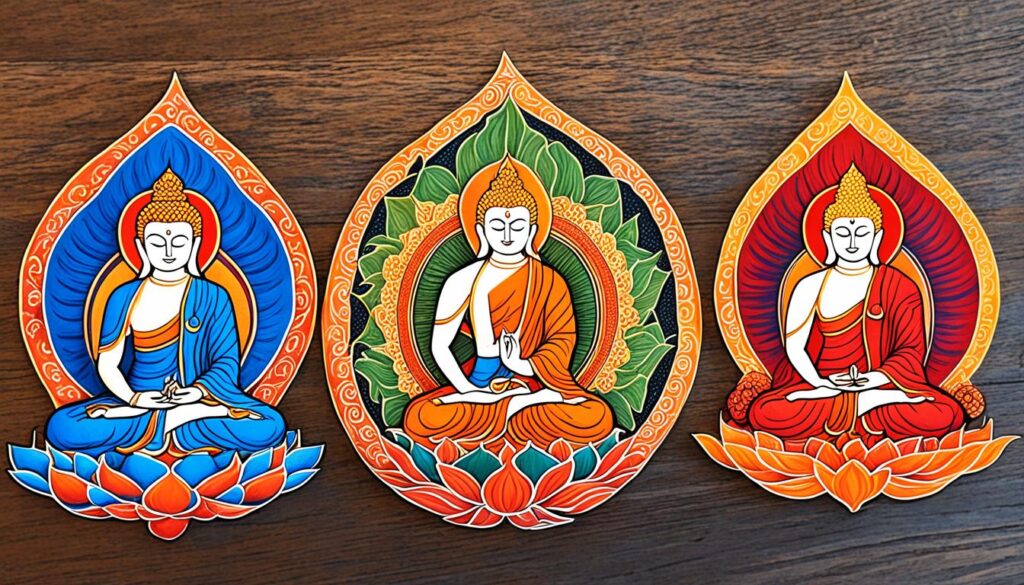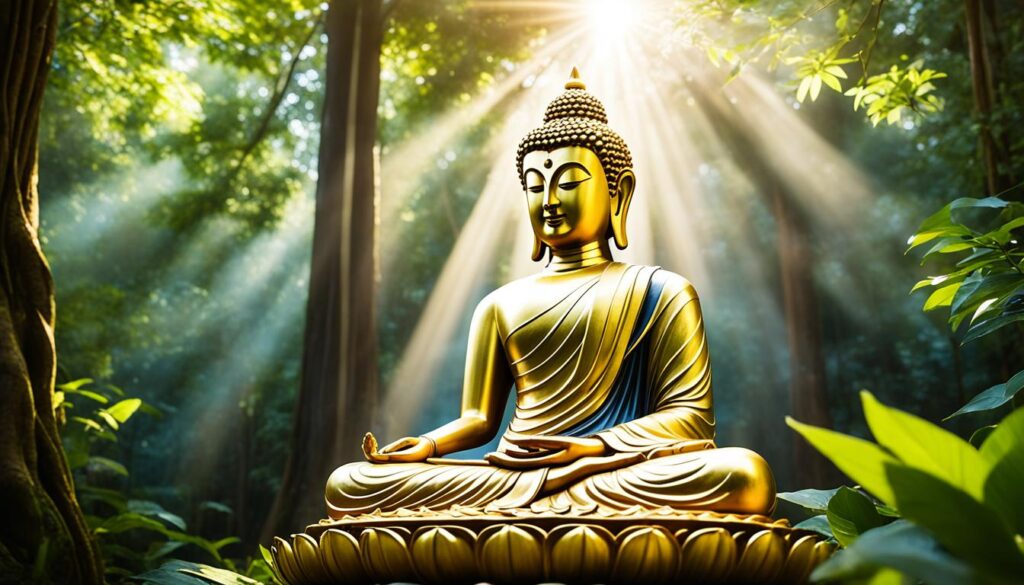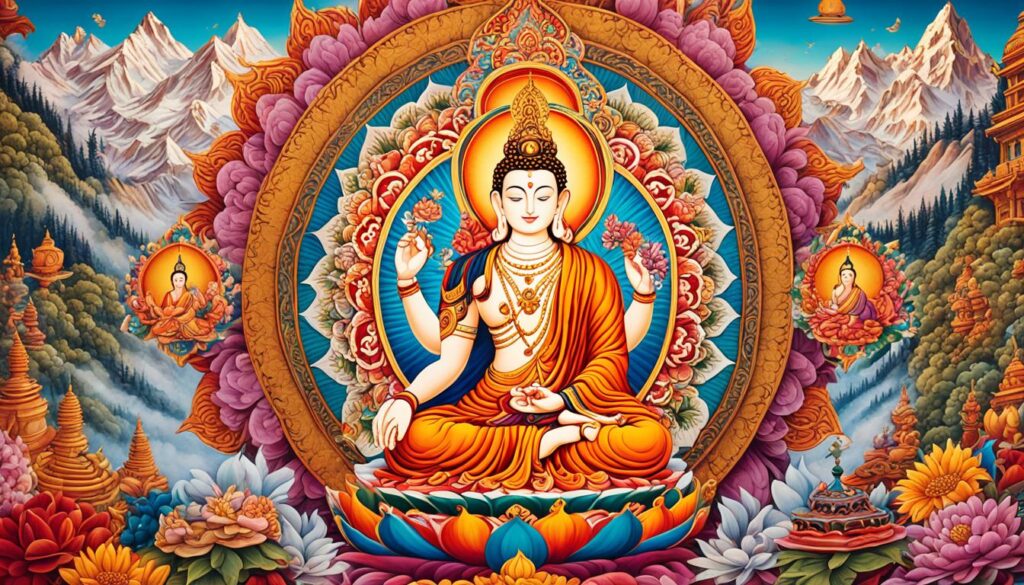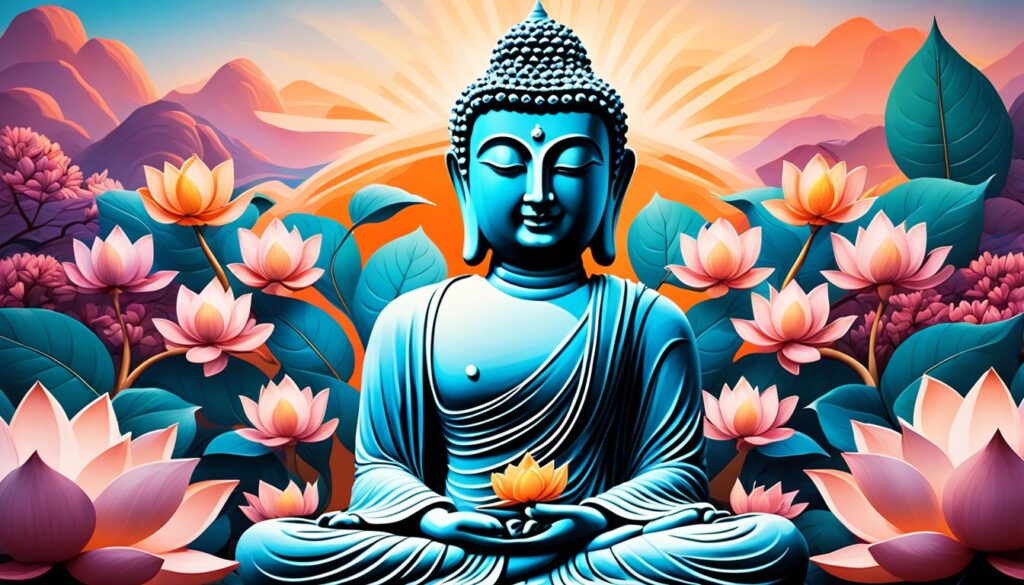“Do not dwell in the past, do not dream of the future, concentrate the mind on the present moment.” – Buddha
Buddhism is a profound spiritual tradition that offers guidance and teachings for individuals seeking enlightenment and inner peace. With its roots in ancient South Asia, Buddhism has evolved into various traditions and schools, each with its own unique practices and beliefs. Understanding the different types of Buddhism is crucial to appreciate the diversity and richness of this religion.
- Mahayana, Theravada, and Vajrayana are the three main types of Buddhism
- Each type has distinct characteristics and teachings
- Mahayana emphasizes compassion and the path of the bodhisattva
- Theravada focuses on the Noble Eightfold Path and monasticism
- Vajrayana incorporates unique practices like tantra and guru yoga
- Buddhism promotes personal and societal harmony through mindfulness and compassion
The Three Yanas: Mahayana, Theravada, and Vajrayana Explained
The Buddha recognized that people have different capacities and styles, so he laid out the Three Yanas or vehicles within Buddhism. These vehicles are like the branches of a tree. The three major vehicles are Mahayana, Theravada, and Vajrayana.
Mahayana Buddhism: This path is commonly followed in China, Taiwan, Japan, and South Korea. Mahayana emphasizes the role models of bodhisattvas, enlightened beings who postpone their own liberation to help others. Its teachings focus on compassion, wisdom, and the aspiration to attain enlightenment for the benefit of all sentient beings.
Theravada Buddhism: This tradition is popular in Sri Lanka, Cambodia, Thailand, Laos, and Burma. Theravada places a strong emphasis on monasticism and meditation. The teachings revolve around the Pali canon, which contains the Buddha’s earliest teachings, and the Noble Eightfold Path, which encompasses ethical conduct, mental discipline, and wisdom.
Vajrayana Buddhism: Falling under the umbrella of Mahayana, Vajrayana is practiced primarily in Tibet, Nepal, Bhutan, and Mongolia. It is known as the “Diamond Vehicle” and offers a faster path to enlightenment. Vajrayana incorporates unique practices, such as tantra, which involves ritual, visualization, and mantra recitation to transform ordinary experiences into spiritual ones. Guru yoga, the practice of connecting with a qualified spiritual teacher, is also central to Vajrayana.
To better understand the differences between Mahayana, Theravada, and Vajrayana Buddhism, refer to the following table:
| Mahayana | Theravada | Vajrayana | |
|---|---|---|---|
| Main Regions | China, Taiwan, Japan, South Korea | Sri Lanka, Cambodia, Thailand, Laos, Burma | Tibet, Nepal, Bhutan, Mongolia |
| Emphasis | Bodhisattvas, compassion, wisdom | Monasticism, meditation | Tantra, ritual, guru yoga |
| Goal | Enlightenment for all sentient beings | Attaining liberation and becoming an arhat | Faster path to enlightenment |

Through these three vehicles, Buddhism offers a rich array of paths for individuals to embark on their spiritual journey. Each tradition provides unique perspectives and practices, catering to different preferences and inclinations. Understanding the Three Yanas can help guide your exploration of Buddhism and determine which path resonates with you the most, enabling you to progress towards enlightenment and personal transformation.
Understanding the Teachings and Practices of Theravada Buddhism
Theravada Buddhism, often referred to as the “Way of the Elders,” is the oldest form of Buddhism that originated in South Asia. It holds significant reverence for the Tipitaka, also known as the Pali canon, which contains the earliest teachings of the Buddha. The fundamental goal of Theravada Buddhism is the cultivation of liberation and the attainment of arhatship, the state of being fully awakened.
The teachings of Theravada Buddhism center around the Noble Eightfold Path, a set of principles that guide individuals towards liberation and the end of suffering. This path encompasses ethical conduct, mental discipline, and wisdom, providing a holistic framework for personal transformation.
The Noble Eightfold Path:
- Right View: Developing a clear understanding of the nature of reality and the Four Noble Truths.
- Right Intention: Cultivating wholesome intentions and renouncing harmful thoughts.
- Right Speech: Practicing truthful, kind, and compassionate communication.
- Right Action: Engaging in actions that are beneficial, ethical, and non-harming.
- Right Livelihood: Pursuing an occupation that aligns with ethical principles and contributes to the welfare of others.
- Right Effort: Making diligent efforts to cultivate wholesome attributes and abandon unwholesome qualities.
- Right Mindfulness: Cultivating moment-to-moment awareness and non-judgmental acceptance of one’s experience.
- Right Concentration: Developing focused attention through meditation to attain deep states of concentration and insight.
In addition to the Noble Eightfold Path, Theravada Buddhism places a strong emphasis on monasticism as a means of deepening one’s spiritual practice. Monastics follow strict rules and guidelines, dedicating their lives to study, meditation, and the pursuit of enlightenment.
Mindfulness meditation is a central practice within Theravada Buddhism. It involves cultivating present-moment awareness and an understanding of the impermanent and interconnected nature of reality. Through mindfulness, individuals develop a deepened sense of clarity, insight, and wisdom.
Understanding the teachings and practices of Theravada Buddhism provides guidance on leading a compassionate and virtuous life while cultivating the path towards liberation and awakening.

Exploring Mahayana Buddhism and the Path of the Bodhisattva
Mahayana Buddhism, also known as the “Great Vehicle,” is the largest school of Buddhism. It offers a profound and inclusive path for individuals seeking enlightenment.
In Mahayana Buddhism, the bodhisattva is a central figure. A bodhisattva is someone who aspires to attain enlightenment for the benefit of all sentient beings. The bodhisattva’s path is driven by compassion and the desire to alleviate suffering in the world.
Compassion is a key virtue in Mahayana teachings. It is the profound empathy and deep understanding of the interconnectedness of all beings. Through cultivating compassion, practitioners aim to develop bodhicitta, the mind of awakening.
Mahayana practices vary across different regions and lineages but share common elements. Meditation is a crucial practice to develop mindfulness and insight. Chanting, known as mantra repetition, is also prevalent in Mahayana Buddhism as a means of focusing the mind and invoking the enlightened qualities of buddhas and bodhisattvas.
Studying sacred scriptures is another important aspect of Mahayana practice. The Pali Canon, the early Buddhist scriptures, holds significance in many Theravada traditions. In contrast, Mahayana has its own set of sutras, such as the Lotus Sutra and the Heart Sutra, which serve as sources of inspiration and guidance.
The Concept of Emptiness in Mahayana Buddhism
In Mahayana philosophy, the concept of emptiness (shunyata) is of profound importance. It teaches that all phenomena lack inherent existence and are interconnected. Emptiness is not a nihilistic void but rather an understanding that everything is dependent on causes and conditions.
This realization of emptiness leads to the dissolution of ego-centered views and fuels the development of compassion. Recognizing the interdependence of all beings, Mahayana practitioners perceive the suffering of others as their own, generating a deep sense of responsibility to alleviate it.
| Key Aspects of Mahayana Buddhism | Practices |
|---|---|
| Compassion | Mahayana Buddhism emphasizes the cultivation of compassion and selfless love for all beings. |
| Bodhisattva Ideal | The path of the bodhisattva is central to Mahayana, embodying the commitment to attain enlightenment for the benefit of all. |
| Meditation | Mahayana practitioners engage in various forms of meditation to cultivate mindfulness, insight, and spiritual growth. |
| Chanting | Chanting mantras and sacred texts is a common practice to invoke the enlightened qualities of buddhas and bodhisattvas. |
| Study of Scriptures | Studying Mahayana sutras, such as the Lotus Sutra and the Heart Sutra, provides guidance and inspiration on the path to enlightenment. |
Exploring Vajrayana Buddhism and its Unique Practices
Vajrayana Buddhism, also known as Tibetan Buddhism, is a subcategory of Mahayana Buddhism and is primarily practiced in Tibet, Nepal, Bhutan, and Mongolia. It is considered the “Diamond Vehicle” and offers a faster path to enlightenment compared to other Buddhist traditions. Vajrayana is rich in unique practices that set it apart from other schools.
The Practice of Tantra
A distinctive feature of Vajrayana Buddhism is its emphasis on tantra, a method that utilizes ritual, symbolism, and visualization to transform ordinary experiences into spiritual ones. Tantra focuses on harnessing the energy within the body and mind to accelerate the path to enlightenment. Through the practice of tantra, practitioners aim to transcend dualistic thinking and attain a state of non-duality.
Guru Yoga: Connecting with the Spiritual Guide
Guru yoga is another prominent practice in Vajrayana Buddhism. This practice involves developing a deep connection with a qualified lama, or spiritual guide. The practitioner engages in visualization and meditation to join their mind with the enlightened mind of the guru. Guru yoga is essential for receiving the blessings and guidance necessary to progress on the Vajrayana path.
It is important to note that practicing Vajrayana Buddhism requires guidance from a qualified lama who has received proper training and transmission from their own guru. The relationship between the student and the lama is crucial, as the lama serves as a spiritual mentor, offering guidance in the complex practices of Vajrayana.

| Key Features of Vajrayana Buddhism |
|---|
| Tantra |
| Guru Yoga |
The Influence of Buddhism on Personal and Societal Harmony
Buddhism’s teachings have a profound impact on personal and societal harmony. Through its principles and practices, Buddhism offers valuable insights and tools to address the modern challenges that individuals and communities face.
Mindfulness, a central aspect of Buddhism, allows individuals to cultivate present-moment awareness and develop a deeper understanding of their thoughts and emotions. By practicing mindfulness, you can learn to observe your mind without judgment and cultivate a sense of inner calm and clarity. This practice enables you to navigate the complexities of everyday life with greater ease and personal harmony.
Compassion is another key teaching in Buddhism. It encourages individuals to extend kindness, empathy, and understanding to both themselves and others. By cultivating compassion, you can foster harmonious relationships and contribute to the well-being of society as a whole.
In a rapidly changing world filled with conflicts, stress, and division, Buddhism provides valuable guidance on how to foster peace and unity. Its teachings emphasize the interconnectedness of all beings and promote a sense of collective responsibility. By practicing compassion and understanding, you can contribute to creating a more harmonious and compassionate society.
Furthermore, Buddhism offers practical tools for navigating the challenges of modern life. Its teachings on impermanence remind us that change is inevitable and that we can find peace by embracing the present moment. The practice of mindfulness and compassion can help individuals find resilience in the face of uncertainty and cultivate a sense of inner stability and peace.
The Role of Buddhism Today
In a world marked by division and discord, Buddhism’s teachings of mindfulness, compassion, and personal harmony are more relevant than ever. By integrating these principles into our daily lives, we can contribute to societal harmony and work towards a more peaceful and compassionate world.

Conclusion
Buddhism is a profound and diverse religion that offers different paths to enlightenment. With its three main types, Mahayana, Theravada, and Vajrayana, Buddhism provides unique teachings and practices that cater to a wide range of individuals. Each tradition emphasizes the goal of liberating oneself from suffering and attaining enlightenment, although they may have different approaches.
Mahayana Buddhism, the largest school, emphasizes the path of the bodhisattva, promoting compassion and wisdom to benefit all sentient beings. Theravada Buddhism, the oldest form, focuses on the cultivation of liberation and becoming an arhat through the Noble Eightfold Path. Vajrayana Buddhism, a subcategory of Mahayana, offers a faster path to enlightenment through practices like tantra and guru yoga.
Exploring the various types of Buddhism can provide valuable insights and guidance on your spiritual journey. Whether you resonate with the compassionate ideals of Mahayana, the disciplined practices of Theravada, or the unique methods of Vajrayana, each tradition offers a wealth of wisdom and teachings that can lead you towards personal growth and understanding. No matter which path you choose, Buddhism offers a profound framework for finding peace, harmony, and enlightenment in today’s complex world.
FAQ
What are the three main types of Buddhism?
The three main types of Buddhism are Mahayana, Theravada, and Vajrayana.
What are the differences between Mahayana, Theravada, and Vajrayana?
Mahayana Buddhism emphasizes the path of the bodhisattva, Theravada Buddhism focuses on monasticism and meditation, and Vajrayana Buddhism offers unique practices like tantra and guru yoga.
Where is Mahayana Buddhism commonly practiced?
Mahayana Buddhism is common in China, Taiwan, Japan, and South Korea.
Where is Theravada Buddhism popular?
Theravada Buddhism is popular in Sri Lanka, Cambodia, Thailand, Laos, and Burma.
Where is Vajrayana Buddhism practiced?
Vajrayana Buddhism is primarily practiced in Tibet, Nepal, Bhutan, and Mongolia.
What is the oldest form of Buddhism?
Theravada Buddhism is known as the “Way of the Elders” and is the oldest form of Buddhism.
What is the focus of Theravada Buddhism?
Theravada Buddhism places importance on the Pali canon, ethical conduct, mental discipline, and the cultivation of liberation.
What is the goal of Mahayana Buddhism?
Mahayana Buddhism emphasizes the goal of the bodhisattva to attain enlightenment for the benefit of all sentient beings.
What are some common practices in Mahayana Buddhism?
Practices in Mahayana Buddhism include meditation, chanting, and studying scriptures.
What is unique about Vajrayana Buddhism?
Vajrayana Buddhism offers a faster path to enlightenment through practices like tantra and guru yoga.
How does Buddhism promote personal and societal harmony?
Buddhism promotes personal and societal harmony through the practice of mindfulness and the cultivation of compassion.

